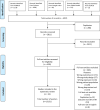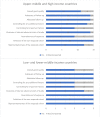Landscaping the evidence of intimate partner violence and postpartum depression: a systematic review
- PMID: 35584869
- PMCID: PMC9119188
- DOI: 10.1136/bmjopen-2021-051426
Landscaping the evidence of intimate partner violence and postpartum depression: a systematic review
Abstract
Objective: To assess the evidence of the association between exposure to intimate partner violence (IPV) and postpartum depression. IPV during pregnancy can have immediate and long-term physical and mental health consequences for the family. Therefore, it has been hypothesised that IPV may affect the risk of developing postpartum depression.
Methods: A systematic review was conducted according to the Preferred Reporting Items for Systematic Reviews and Meta-Analyses guidelines. PubMed, Embase, Global Health Library, Scopus and Google scholar were searched for published studies without restrictions on language, time or study design (up to May 2020). Studies were included if they assessed postpartum depression using the Edinburg Postnatal Depression Scale (cut-off≥10), among women who had been exposed to IPV (emotional, physical and/or sexual abuse). The quality of studies was judged according to the Newcastle-Ottawa scale.
Results: A total of 33 studies were included in the review (participants n=131 131). The majority of studies found an association between exposure to IPV and the development of signs of postpartum depression. Overall, studies measured both exposure and outcome in various ways and controlled for a vast number of different confounders. Thirty percent of the studies were set in low-income and lower-middle-income countries while the rest were set in upper-middle-income and high-income countries and the association did not differ across settings. Among the studies reporting adjusted OR (aOR) (n=26), the significant aOR ranged between 1.18 and 6.87 (95% CI 1.12 to 11.78). The majority of the studies were judged as 'good quality' (n=20/33).
Conclusion: We found evidence of an association between exposure to IPV and the development of signs of postpartum depression. Meta-analysis or individual patient data meta-analysis is required to quantify the magnitude of the association between IPV and postpartum depression.
Prospero registration number: CRD42020209435.
Keywords: Depression & mood disorders; MENTAL HEALTH; Maternal medicine; Reproductive medicine.
© Author(s) (or their employer(s)) 2022. Re-use permitted under CC BY-NC. No commercial re-use. See rights and permissions. Published by BMJ.
Conflict of interest statement
Competing interests: None declared.
Figures




References
-
- World Health Organization . Violence against women, 2019. Available: https://www.who.int/news-room/fact-sheets/detail/violence-against-women [Accessed 04 Sep 2019].
-
- Claudia Carcia-Moreno AG, Knerr W. Understanding and addressing violence against women. In: Ramsay S, ed. Intimate partner violence. 12, 2012.
Publication types
MeSH terms
LinkOut - more resources
Full Text Sources
Medical
